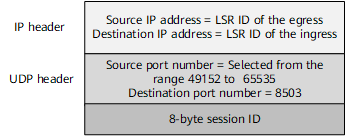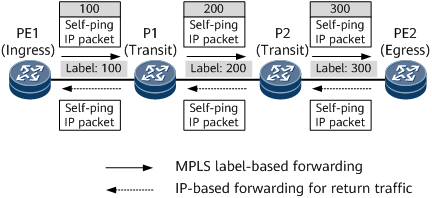Self-Ping
Self-ping is a connectivity check method for RSVP-TE LSPs.
Background
After an RSVP-TE LSP is established, the system sets the LSP status to up, without waiting for forwarding relationships to be completely established between nodes on the forwarding path. If service traffic is imported to the LSP before all forwarding relationships are established, some early traffic may be lost.
Self-ping can address this issue by checking whether an LSP can properly forward traffic.
Implementation
With self-ping enabled, an ingress constructs a UDP packet carrying an 8-byte session ID and adds an IP header to the packet to form a self-ping IP packet. Figure 1 shows the format of a self-ping IP packet. In a self-ping IP packet, the destination IP address is the LSR ID of the ingress, the source IP address is the LSR ID of the egress, the destination port number is 8503, and the source port number is a variable ranging from 49152 to 65535.
Figure 2 shows the self-ping process. In the example network, a P2P RSVP-TE tunnel is established from PE1 to PE2. Each of the numbers 100, 200, and 300 is an MPLS label assigned by a downstream node to its upstream node through RSVP Resv messages.
Self-ping is enabled on PE1 (ingress). After PE1 receives a Resv message, it constructs a self-ping IP packet and forwards the packet along the P2P RSVP-TE LSP. The outgoing label of the packet is 100, same as the label carried in the Resv message. After the self-ping IP packet is forwarded to PE2 (egress) hop by hop, the label is popped out, and the self-ping IP packet is restored.
The destination IP address of the packet is the LSR ID of PE1. PE2 searches the IP routing table for a route matching the destination IP address of the self-ping IP packet, and then sends the packet to PE1 along the matched route. After PE1 receives the self-ping IP packet, PE1 finds a P2P RSVP-TE LSP that matches the session ID carried in the packet. If a matching LSP is found, PE1 considers the LSP normal, sets the LSP status to up, and uses the LSP to transport traffic. The LSP self-ping test is then complete.
If PE1 does not receive the self-ping IP packet, it sends a new self-ping packet. If PE1 does not receive the self-ping IP packet before the detection period expires, it considers the P2P RSVP-TE LSP faulty and does not use the LSP to transport traffic.
Benefits
Self-ping detects the actual status of RSVP-TE LSPs, improving service reliability.

